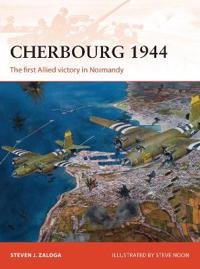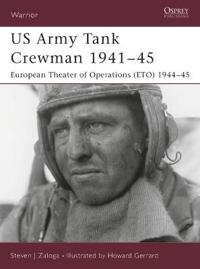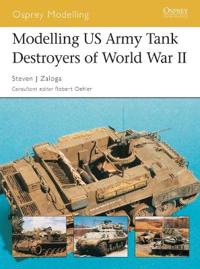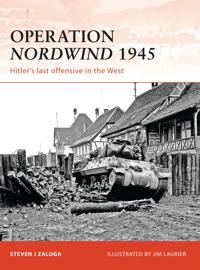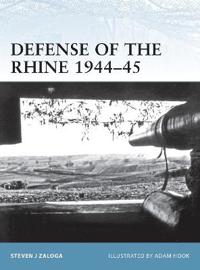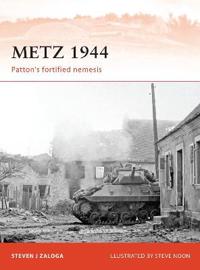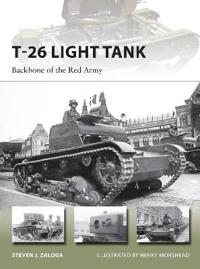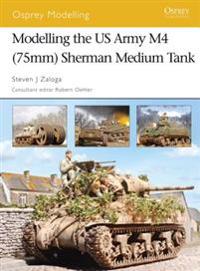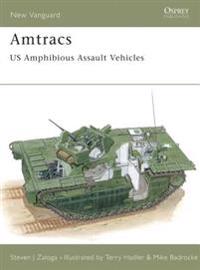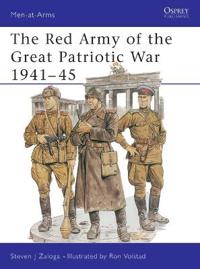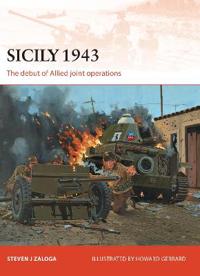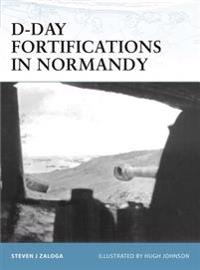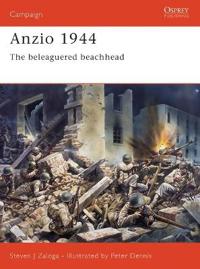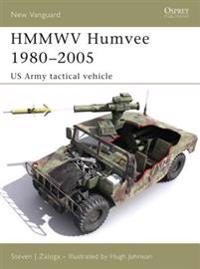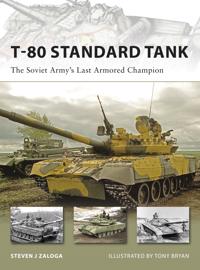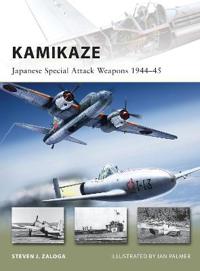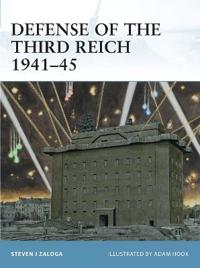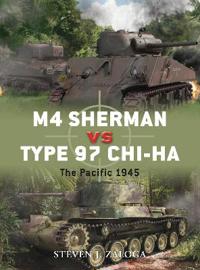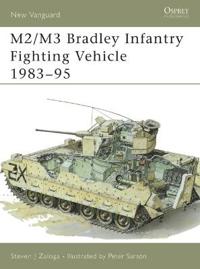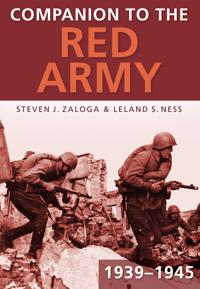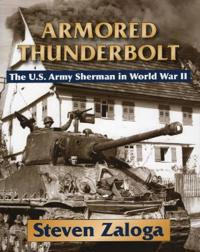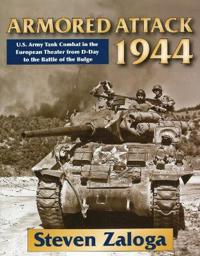Cherbourg 1944 (Pocket)
avSteven Zaloga, Steve (ILT) Noon, Steven Zaloga
ISBN: 9781472806635 - UTGIVEN: 2015-03Steven Zaloga offers up a rigorous and absorbing study of the first major Allied operation in Normandy after the D-Day landings - the capture of Cherbourg. Blending expert analysis, specially commissioned artwork and illustrative maps, this book tells the story of the bitter struggle to capture this[...]
Us Army Tank Crewman 1941-45 (Pocket)
avSteven Zaloga, Howard (ILT) Gerrard, Steven Zaloga
ISBN: 9781841765549 - UTGIVEN: 2004-07This title is structured around the career of a single tanker from 37th Tank Battalion, 4th Armored Division, revealing what it was like to live and fight in a medium tank. The focus is largely on the crew of an M4 Sherman, though light tank service is also studied. Tank operation required a well tr[...]
Modelling Us Tank Destroyers Of World War Ii (Pocket)
avSteven Zaloga, Robert (EDT) Oehler, Steven Zaloga
ISBN: 9781841767994 - UTGIVEN: 2004-10The US Tank Destroyer program was introduced as a cost-effective way of dealing with German armour. As opposed to most of the other combatant powers of WWII, the US did not want to use its tank battalions to confront opposing armour. Rather, specialised tank destroyer battalions, both towed and self[...]
Operation Nordwind 1945 (Pocket)
avSteven Zaloga, Jim Laurier, Steven Zaloga
ISBN: 9781846036835 - UTGIVEN: 201006Operation Nordwind is one of the lesser known campaigns of World War II yet one of the more intriguing. Largely overshadowed by the Battle of the Bulge further north, Nordwind was the last great operation by the Waffen-SS Panzer divisions in the west, and the last time the Wehrmacht was on the offen[...]
Defense of the Rhine 1944-45 (Pocket)
avSteven Zaloga, Adam (ILT) Hook, Steven Zaloga
ISBN: 9781849083874 - UTGIVEN: 2011-03The Rhine River represented the last natural defensive barrier for the Third Reich in the fall of 1944. Although Hitler had been reluctant to allow the construction of tactical defense lines in France, the final defense of the Reich was another matter. As a result, construction of a Rhine defense li[...]
Metz 1944 (Pocket)
avSteven Zaloga, Steve Noon, Steven Zaloga
ISBN: 9781849085915 - UTGIVEN: 201203General George Patton's most controversial campaign was the series of battles in autumn 1944 along the German frontier which centered on the fortified city of Metz. It took nearly four months, from September to December 1944, for Patton's Third Army to capture the Metz-Thionville fortified zone. In [...]
T-26 Light Tank (Pocket)
avSteven Zaloga
ISBN: 9781472806253 - UTGIVEN: 2015-01The T-26 was the first major Soviet armour program of the 1930s, beginning as a license-built version of the British Vickers 6-ton export tank. Although the T-26 retained the basic Vickers hull and suspension, the Red Army began to make extensive changes to the turret and armament, starting with the[...]
Modelling the Us Army M4 (75mm) Sherman Medium Tank (Pocket)
avSteven Zaloga
ISBN: 9781841769653 - UTGIVEN: 2006-11The Sherman was the most widely used Allied tank of World War II and was built in larger numbers than all German tanks combined. There was also a huge number of variants, powered by different engines, and manufactured with different types of hulls and turrets. This book presents an expert guide to m[...]
Amtracs (Pocket)
avSteven Zaloga
ISBN: 9781855328501 - UTGIVEN: 1999-10The first prototype for the LVT (Landing Vehicle Tracked) was completed in July 1941, its design based on the Alligator, a tracked amphibious vehicle developed for rescue operations in the swamps of Florida. Though the early conception of amtrac operations envisioned using LVTs solely as supply vehi[...]
Red Army of the Great Patriotic War 1941-5 (Pocket)
avSteven J. Zaloga, Ronald (ILT) Volstad, Steven J. Zaloga
ISBN: 9780850459395 - UTGIVEN: 1989-10The German invasion in 1941 led to a series of staggering defeats for the Russians. In the first five months of fighting, the Soviets lost about four million men, amounting to 80 per cent of the total strength of the ground forces at the time of the outbreak of the war. Yet the Red Army managed to h[...]
Panzer IV Vs Sherman (Pocket)
avSteven J. Zaloga, Richard (ILT) Chasemore, Steven J. Zaloga
ISBN: 9781472807601 - UTGIVEN: 2015-08As the Allies attempted to break out of Normandy, it quickly became apparent that there would be no easy victory over the Germans, and that every scrap of territory on the way to Berlin would have to be earned through hard fighting. This study concentrates on the ferocious battles between the German[...]
Sicily 1943 (Pocket)
avSteven J. Zaloga, Howard Gerrard, Steven J. Zaloga
ISBN: 9781780961262 - UTGIVEN: 201301Not only did the Sicily operation represent a watershed in tactical development of combined arms tactics, it was also an important test for future Allied joint operations. Senior British commanders left the North African theater with a jaundiced and dismissive view of the combat capabilities of the [...]
D-Day Fortifications in Normandy (Pocket)
avSteven J. Zaloga, Hugh (ILT) Johnson, Steven J. Zaloga
ISBN: 9781841768762 - UTGIVEN: 2005-11The coastal defenses in Normandy along the D-Day beaches were less thorough than other Atlantic Wall defenses, such as the Pas de Calais, where the Germans expected the main attack. However, they still proved to be formidable obstacles for the Allied invasion force. Rommel stressed the need to defea[...]
Anzio 1944 (Pocket)
avSteven J. Zaloga, Peter (ILT) Dennis, Steven J. Zaloga
ISBN: 9781841769134 - UTGIVEN: 2005-08In January 1944, the Allies made the decision to land at Anzio in order to overcome the stalemate at Cassino. The amphibious landing has become one of the most controversial campaigns of World War II. Three months of World War I-style trench warfare was brought on by a series of missteps from the Al[...]
Hmmwv Humvee 1980-2005 (Pocket)
avSteven J. Zaloga, Hugh (ILT) Johnson, Steven J. Zaloga
ISBN: 9781841769462 - UTGIVEN: 2006-04The HMMWV has set the world standard for army tactical vehicles, since its introduction into the US Army in the 1980s. The Humvee marks another step in the evolution of small tactical vehicles, first started by the legendary Jeep of World War II. Modern armies have a need for a larger vehicle able t[...]
T-80 Standard Tank (Pocket)
avSteven J. Zaloga, Tony (ILT) Bryan, Steven J. Zaloga
ISBN: 9781846032448 - UTGIVEN: 2009-02The Soviet T-80 Standard Tank was the last tank fielded before the Soviet collapse, and the most controversial. Despite having the most sophisticated fire controls and multi-layer armor ever fielded on a Soviet tank, its turbine power plant (rather than a conventional diesel) remained a source of co[...]
The Atlantic Wall (2) (Pocket)
avSteven J. Zaloga, Adam (ILT) Hook, Steven J. Zaloga
ISBN: 9781846033933 - UTGIVEN: 2009-11Germany's Atlantic Wall was the most ambitious military fortification program of World War II. Following its conquest of Western Europe, Germany had to defend some 5,000km of Atlantic coastline from the Spanish border to the Arctic Circle. The United States' entry into the war and the inevitability [...]
Kamikaze (Pocket)
avSteven J. Zaloga, Ian (ILT) Palmer, Steven J. Zaloga
ISBN: 9781849083539 - UTGIVEN: 2011-06"Kamikaze: Japanese Special Attack Weapons, 1944-45".
Eisenhower (Pocket)
avSteven J. Zaloga, Steve (ILT) Noon, Steven J. Zaloga
ISBN: 9781849083591 - UTGIVEN: 2011-08"Eisenhower".
Defense of the Third Reich 1941-45 (Pocket)
avSteven J. Zaloga, Adam Hook, Steven J. Zaloga
ISBN: 9781849085939 - UTGIVEN: 201210Starting in 1940, Germany was subjected to a growing threat of Allied bomber attack. The RAF night bombing offensive built up in a slow but unrelenting crescendo through the Ruhr campaign in the summer of 1944 and culminating in the attacks on Berlin in the autumn and early winter of 1943-44. They w[...]
M4 Sherman Vs Type 97 Chi-Ha (Pocket)
avSteven J. Zaloga, Richard Chasemore, Steven J. Zaloga
ISBN: 9781849086387 - UTGIVEN: 201205Although US and Japanese tank forces first clashed in 1941, it was on in 1944 that tank-vs-tank action became more common as both sides poured larger numbers of tanks into the combat zone. These battles were a means of demonstrating each side's latest tank technology. For the US, the pinnacle of the[...]
M2/M3 Bradley Infantry Fighting Vehicle 1983-95 (Pocket)
avSteven J. Zaloga, Peter (ILT) Sarson, Steven J. Zaloga
ISBN: 9781855325388 - UTGIVEN: 1996-01One of the most sophisticated armoured fighting vehicles in the world, the M2/M3 Bradley is the United States equivalent of the British Warrior, combining the role of personnel carrier with the formidable armament of a 25mm cannon and TOW anti-tank missiles. With a maximum road speed of 66kmh it als[...]
Companion to the Red Army 1939-45 (Häftad)
avSteven J. Zaloga, Leland S. Ness
ISBN: 9780752454757 - UTGIVEN: 200911Stalin's Red Army entered the Second World War as a relatively untried fighting force. In 1941, with the launch of Operation 'Barbarossa', it joined the battle with Hitler's army, the most powerful in history. After a desperate war of attrition over four years, the Red Army defeated the Nazis on the[...]
Armored Thunderbolt (Inbunden)
avSteven J. Zaloga
ISBN: 9780811704243 - UTGIVEN: 200811This book features hundreds of photos, including many never published before. It provides riveting accounts of armoured warfare in World War II. It compares the Sherman to other tanks, including the Panther and Tiger. The author is a world-renowned expert on the Sherman tank and American armour. Som[...]
Armored Attack 1944 (Inbunden)
avSteven J. Zaloga
ISBN: 9780811707695 - UTGIVEN: 201110* An exploration of the U.S. Army Tank combat that played a vital role in the wining of World War II The tank played a key role in many of the battles of World War II; it was an indispensable weapon that could halt entire armies and wreak havoc on the battlefield. Early in the war it was the German[...]

